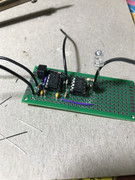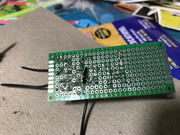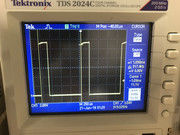triangles
Well-known member
6-7-18
Seeing as how I have no back up for my EVSE should the magic smoke ever leak out, and I'm a cheap bastard, I started pondering a cheap temporary solution should my EVSE ever fail. Public charging options are sparse and quite inconvenient... I stumbled across the BareEVSE over on the Leaf forum. [color=#0000FF][u]http://www.mynissanleaf.com/viewtopic.php?t=11474[/u][/color] Now I don't think I want to go quite as "bare" as this guy going with the absolute minimum kludge to get the car to charge. I'm thinking make a minimal (read cheap) EVSE to function as the glorified extension cord that an EVSE really is. I am well aware of the risks associated with all the safety features I'll be bypassing/omitting and am quite capable of managing that risk. So please, there is absolutely no need to harp on the dangers of omitting this or that. The intent is for an emergency backup not an daily use EVSE. For daily use you really should use an EVSE with all safety features intact!
This is a back burner project so it will probably be fall or later before I finish this. I'll keep updating this first post so someone stumbling upon this after it's completed wont have to wade thru pages of posts to figure out what was done. Hopefully the originator of BareEVSE doesn't mind me hijacking the name :lol:
First, the usual disclaimers: If you are unfamiliar with electronics or being safe with high voltages, DO NOT attempt to replicate anything I do. Another way to put it is if you do not understand the risks or are not capable of managing the risks of omitting safety features in an EVSE, DO NOT attempt to replicate what I do here! In other words if you are an idiot and hurt/kill yourself replicating what I do, you only have your self to blame, not me. On second though the world has too many idiots so please if you are one, get out of the gene pool before you accidentally manage to procreate! :lol:
I consider the OEM EVSE (crippled at L1) to be useful only as a paperweight. My first attempt to Adapt Ford's 120v charge cable to 240v failed. First it shorted out, then I'm not sure if the circuity was damaged as a result of the short but after I replaced the relays, the board would fault after charging a few minutes. I suspect I simply wasn't able to fool some logic on the board that was somehow able to see that I was using the ground as a neutral. If you are lucky enough to have the newer ones, they work out of the box on 240V with a simple plug adapter. I don't know if this is all newer ones so try at your own risk. If the magic smoke comes out your OEM EVSE was not 240V compatible. :lol:
First it shorted out, then I'm not sure if the circuity was damaged as a result of the short but after I replaced the relays, the board would fault after charging a few minutes. I suspect I simply wasn't able to fool some logic on the board that was somehow able to see that I was using the ground as a neutral. If you are lucky enough to have the newer ones, they work out of the box on 240V with a simple plug adapter. I don't know if this is all newer ones so try at your own risk. If the magic smoke comes out your OEM EVSE was not 240V compatible. :lol:
Design Objective:
In the simplest possible way and using parts from the OEM EVSE, build a cheap L1/L2 EVSE to charge the car in the event my primary EVSE fails. For simplicity sake only the bare minimum necessary to supply juice to the car will be considered. This means it will be far from idiot proof like normal EVSEs and may present risks that need to be mitigated by knowledge of the dangers and how not to kill/damage yourself as a result there of.
Initial thoughts:
I could remove the guts from the OEM EVSE box and only reuse the 12V relays. The EVSE will need to generate pilot signal and respond to the car to energize relays to provide power. BareEVSE provides a good starting point. I plan on implementing a modified version of his pilot signal circuit to be a fixed charge current. Also I will likely have to modify the circuit to provide enough power to energize the relays from the OEM EVSE. A 100-250V 12VDC power supply will make it L1/L2 capable although I'd probably never use L1, but hey this is an emergency back up so it's possible L1 is the only option in a particular situation. So if it's no extra cost, why not have that capability? I believe the OEM EVSE's wires are 16ga which means they have an ampacity of 13A so I wouldn't want to go higher than the 12A it currently uses. This would give me 2.88kW and by my rough calculations that means a little over 8 hours to charge from a dead battery. Totally acceptable for an overnite charge and rarely do I run my FFE to empty. Another possibility for higher current would be to put the relays/circuitry in the J1772 handle and use a higher amperage cord. The trick with that will be to figure out how to fit it all in the plug handle and keeping cost down. Also you'd be constrained by the amperages of the OEM J1772 plug and relays. I'm guessing unless it's molded into the plastic determining the rating of the OEM J1772 plug would be almost impossible so that might be reason enough to keep it simple and just gut the OEM box keeping it at 12A. We're already cutting enough corners lets not risk damage to the inlet on the car.
What are the main safety considerations involved with this approach? My biggest concern is that if the pilot signal is shorted the relays will be energized. This danger is easily mitigated by not trying to touch the J1772 plug pins and assuming they are always hot. The FFE does not try to pull any current when initially plugged in so there's no risk of arcing at plug-in and damaging the car's receptacle. There is no stuck relay check so like above always assume the J1772 pins are hot. No GFCI so same precautions apply any other 240V appliance that's not GFCI protected.
I'll update when I've had time to figure out a schematic and look at the hardware.
Update 06-08-18:
Verified the following info:
-relays are rated to 16A 250V
-wire is 16ga (ampacity is 13A)
-writing on the J1772 plug says it is only rated for 12A
-J1772 plug handle has some rubber molded over it and does not look like it can be disassembled in a nondestructive fashion.
So the above basically means NONE of this EVSE is usable if I want more than 12A. So I guess 12A 120V/240V is what it will be designed for.
So I guess 12A 120V/240V is what it will be designed for.
Update 06-11-18:
I think I got the schematic figured out. Now to buy some parts and see if it works. I heavily borrowed (copied) from what BareEVSE started with but didn't want to mess with pots. The J1772 spec is pretty flexible as the 1kHz pilot is supposed to be good as long as it falls between 980Hz and 1020Hz So hopefully the tolerance of the resistors is good enough to get me in this range. I'll scope the output and see what I get before blindly trying it on a car. I added a LED to indicate when the relays are energized. I changed transistors to one that can handle 200mA since the the two relays and LED are too close for my comfort to the 100mA max of the transistor used in the original BareEVSE. I didn't bother to check if R9 is sized properly. I may have to make it a little smaller. My electronic skills are pretty much limited to being dangerous. If anyone sees something in the schematic that is wrong please let me know.

Update 06-21-18:
So here's the new schematic:

I assembled it and started testing:


After trying to figure out why I wasn't getting anything on the pilot I realized I hadn't connected Pin 7 of the timer... DOH! After correcting that I was pleased to see this:
After correcting that I was pleased to see this:

 YAY! I have a signal that looks sort of right but wait... It's only 918Hz and is about 22% duty cycle... should be 1000 and 20%.
YAY! I have a signal that looks sort of right but wait... It's only 918Hz and is about 22% duty cycle... should be 1000 and 20%.  I feel stupid now for even trying. I thought using 1% tolerance parts would be good enough. It would be for the resistors but after looking at the math for the timing capacitor, it would pretty much have to be exact to get close to 1000Hz. So that's why the original guy used POTs. DOH. I now see why 555 times are really only appropriate for hobby and learning experiences. Back to the drawing board. I think I found something better that will work but is probably less than ideal. For those electronics gurus out there I'm open to suggestions for a cheap simple way to generate a 12V 1000Hz signal with 20% duty cycle... I also think I"m gonna change the name to CheapEVSE since my objective really is just a cheap EVSE.
I feel stupid now for even trying. I thought using 1% tolerance parts would be good enough. It would be for the resistors but after looking at the math for the timing capacitor, it would pretty much have to be exact to get close to 1000Hz. So that's why the original guy used POTs. DOH. I now see why 555 times are really only appropriate for hobby and learning experiences. Back to the drawing board. I think I found something better that will work but is probably less than ideal. For those electronics gurus out there I'm open to suggestions for a cheap simple way to generate a 12V 1000Hz signal with 20% duty cycle... I also think I"m gonna change the name to CheapEVSE since my objective really is just a cheap EVSE.
Seeing as how I have no back up for my EVSE should the magic smoke ever leak out, and I'm a cheap bastard, I started pondering a cheap temporary solution should my EVSE ever fail. Public charging options are sparse and quite inconvenient... I stumbled across the BareEVSE over on the Leaf forum. [color=#0000FF][u]http://www.mynissanleaf.com/viewtopic.php?t=11474[/u][/color] Now I don't think I want to go quite as "bare" as this guy going with the absolute minimum kludge to get the car to charge. I'm thinking make a minimal (read cheap) EVSE to function as the glorified extension cord that an EVSE really is. I am well aware of the risks associated with all the safety features I'll be bypassing/omitting and am quite capable of managing that risk. So please, there is absolutely no need to harp on the dangers of omitting this or that. The intent is for an emergency backup not an daily use EVSE. For daily use you really should use an EVSE with all safety features intact!
This is a back burner project so it will probably be fall or later before I finish this. I'll keep updating this first post so someone stumbling upon this after it's completed wont have to wade thru pages of posts to figure out what was done. Hopefully the originator of BareEVSE doesn't mind me hijacking the name :lol:
First, the usual disclaimers: If you are unfamiliar with electronics or being safe with high voltages, DO NOT attempt to replicate anything I do. Another way to put it is if you do not understand the risks or are not capable of managing the risks of omitting safety features in an EVSE, DO NOT attempt to replicate what I do here! In other words if you are an idiot and hurt/kill yourself replicating what I do, you only have your self to blame, not me. On second though the world has too many idiots so please if you are one, get out of the gene pool before you accidentally manage to procreate! :lol:
I consider the OEM EVSE (crippled at L1) to be useful only as a paperweight. My first attempt to Adapt Ford's 120v charge cable to 240v failed.
Design Objective:
In the simplest possible way and using parts from the OEM EVSE, build a cheap L1/L2 EVSE to charge the car in the event my primary EVSE fails. For simplicity sake only the bare minimum necessary to supply juice to the car will be considered. This means it will be far from idiot proof like normal EVSEs and may present risks that need to be mitigated by knowledge of the dangers and how not to kill/damage yourself as a result there of.
Initial thoughts:
I could remove the guts from the OEM EVSE box and only reuse the 12V relays. The EVSE will need to generate pilot signal and respond to the car to energize relays to provide power. BareEVSE provides a good starting point. I plan on implementing a modified version of his pilot signal circuit to be a fixed charge current. Also I will likely have to modify the circuit to provide enough power to energize the relays from the OEM EVSE. A 100-250V 12VDC power supply will make it L1/L2 capable although I'd probably never use L1, but hey this is an emergency back up so it's possible L1 is the only option in a particular situation. So if it's no extra cost, why not have that capability? I believe the OEM EVSE's wires are 16ga which means they have an ampacity of 13A so I wouldn't want to go higher than the 12A it currently uses. This would give me 2.88kW and by my rough calculations that means a little over 8 hours to charge from a dead battery. Totally acceptable for an overnite charge and rarely do I run my FFE to empty. Another possibility for higher current would be to put the relays/circuitry in the J1772 handle and use a higher amperage cord. The trick with that will be to figure out how to fit it all in the plug handle and keeping cost down. Also you'd be constrained by the amperages of the OEM J1772 plug and relays. I'm guessing unless it's molded into the plastic determining the rating of the OEM J1772 plug would be almost impossible so that might be reason enough to keep it simple and just gut the OEM box keeping it at 12A. We're already cutting enough corners lets not risk damage to the inlet on the car.
What are the main safety considerations involved with this approach? My biggest concern is that if the pilot signal is shorted the relays will be energized. This danger is easily mitigated by not trying to touch the J1772 plug pins and assuming they are always hot. The FFE does not try to pull any current when initially plugged in so there's no risk of arcing at plug-in and damaging the car's receptacle. There is no stuck relay check so like above always assume the J1772 pins are hot. No GFCI so same precautions apply any other 240V appliance that's not GFCI protected.
I'll update when I've had time to figure out a schematic and look at the hardware.
Update 06-08-18:
Verified the following info:
-relays are rated to 16A 250V
-wire is 16ga (ampacity is 13A)
-writing on the J1772 plug says it is only rated for 12A
-J1772 plug handle has some rubber molded over it and does not look like it can be disassembled in a nondestructive fashion.
So the above basically means NONE of this EVSE is usable if I want more than 12A.
Update 06-11-18:
I think I got the schematic figured out. Now to buy some parts and see if it works. I heavily borrowed (copied) from what BareEVSE started with but didn't want to mess with pots. The J1772 spec is pretty flexible as the 1kHz pilot is supposed to be good as long as it falls between 980Hz and 1020Hz So hopefully the tolerance of the resistors is good enough to get me in this range. I'll scope the output and see what I get before blindly trying it on a car. I added a LED to indicate when the relays are energized. I changed transistors to one that can handle 200mA since the the two relays and LED are too close for my comfort to the 100mA max of the transistor used in the original BareEVSE. I didn't bother to check if R9 is sized properly. I may have to make it a little smaller. My electronic skills are pretty much limited to being dangerous. If anyone sees something in the schematic that is wrong please let me know.

Update 06-21-18:
So here's the new schematic:

I assembled it and started testing:


After trying to figure out why I wasn't getting anything on the pilot I realized I hadn't connected Pin 7 of the timer... DOH!




































